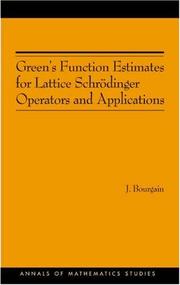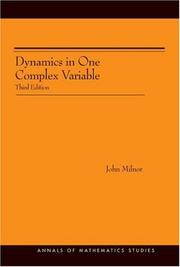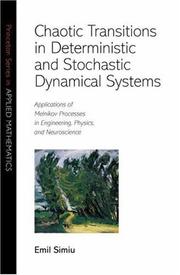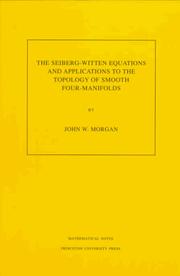| Listing 1 - 4 of 4 |
Sort by
|

ISBN: 0691120978 1322075719 1400837146 0691120986 9780691120980 9781400837144 9780691120973 9781322075716 Year: 2004 Publisher: Princeton, NJ
Abstract | Keywords | Export | Availability | Bookmark
 Loading...
Loading...Choose an application
- Reference Manager
- EndNote
- RefWorks (Direct export to RefWorks)
This book presents an overview of recent developments in the area of localization for quasi-periodic lattice Schrödinger operators and the theory of quasi-periodicity in Hamiltonian evolution equations. The physical motivation of these models extends back to the works of Rudolph Peierls and Douglas R. Hofstadter, and the models themselves have been a focus of mathematical research for two decades. Jean Bourgain here sets forth the results and techniques that have been discovered in the last few years. He puts special emphasis on so-called "non-perturbative" methods and the important role of subharmonic function theory and semi-algebraic set methods. He describes various applications to the theory of differential equations and dynamical systems, in particular to the quantum kicked rotor and KAM theory for nonlinear Hamiltonian evolution equations. Intended primarily for graduate students and researchers in the general area of dynamical systems and mathematical physics, the book provides a coherent account of a large body of work that is presently scattered in the literature. It does so in a refreshingly contained manner that seeks to convey the present technological "state of the art."
Schrödinger operator. --- Green's functions. --- Hamiltonian systems. --- Evolution equations. --- Evolutionary equations --- Equations, Evolution --- Equations of evolution --- Hamiltonian dynamical systems --- Systems, Hamiltonian --- Functions, Green's --- Functions, Induction --- Functions, Source --- Green functions --- Induction functions --- Source functions --- Operator, Schrödinger --- Differential equations --- Differentiable dynamical systems --- Potential theory (Mathematics) --- Differential operators --- Quantum theory --- Schrödinger equation --- Almost Mathieu operator. --- Analytic function. --- Anderson localization. --- Betti number. --- Cartan's theorem. --- Chaos theory. --- Density of states. --- Dimension (vector space). --- Diophantine equation. --- Dynamical system. --- Equation. --- Existential quantification. --- Fundamental matrix (linear differential equation). --- Green's function. --- Hamiltonian system. --- Hermitian adjoint. --- Infimum and supremum. --- Iterative method. --- Jacobi operator. --- Linear equation. --- Linear map. --- Linearization. --- Monodromy matrix. --- Non-perturbative. --- Nonlinear system. --- Normal mode. --- Parameter space. --- Parameter. --- Parametrization. --- Partial differential equation. --- Periodic boundary conditions. --- Phase space. --- Phase transition. --- Polynomial. --- Renormalization. --- Self-adjoint. --- Semialgebraic set. --- Special case. --- Statistical significance. --- Subharmonic function. --- Summation. --- Theorem. --- Theory. --- Transfer matrix. --- Transversality (mathematics). --- Trigonometric functions. --- Trigonometric polynomial. --- Uniformization theorem.

ISBN: 9780691124889 9780691124872 0691124884 0691124876 9786613001481 1400835534 1283001489 9781400835539 9781283001489 6613001481 Year: 2006 Publisher: Princeton, N.J. : Princeton University Press,
Abstract | Keywords | Export | Availability | Bookmark
 Loading...
Loading...Choose an application
- Reference Manager
- EndNote
- RefWorks (Direct export to RefWorks)
This volume studies the dynamics of iterated holomorphic mappings from a Riemann surface to itself, concentrating on the classical case of rational maps of the Riemann sphere. This subject is large and rapidly growing. These lectures are intended to introduce some key ideas in the field, and to form a basis for further study. The reader is assumed to be familiar with the rudiments of complex variable theory and of two-dimensional differential geometry, as well as some basic topics from topology. This third edition contains a number of minor additions and improvements: A historical survey has been added, the definition of Lattés map has been made more inclusive, and the écalle-Voronin theory of parabolic points is described. The résidu itératif is studied, and the material on two complex variables has been expanded. Recent results on effective computability have been added, and the references have been expanded and updated. Written in his usual brilliant style, the author makes difficult mathematics look easy. This book is a very accessible source for much of what has been accomplished in the field.
Functions of complex variables --- Holomorphic mappings --- Riemann surfaces --- Fonctions d'une variable complexe --- Applications holomorphes --- Riemann, surfaces de --- Holomorphic mappings. --- Mappings, Holomorphic --- Functions of complex variables. --- Riemann surfaces. --- Surfaces, Riemann --- Functions --- Functions of several complex variables --- Mappings (Mathematics) --- Complex variables --- Elliptic functions --- Functions of real variables --- Absolute value. --- Addition. --- Algebraic equation. --- Attractor. --- Automorphism. --- Beltrami equation. --- Blaschke product. --- Boundary (topology). --- Branched covering. --- Coefficient. --- Compact Riemann surface. --- Compact space. --- Complex analysis. --- Complex number. --- Complex plane. --- Computation. --- Connected component (graph theory). --- Connected space. --- Constant function. --- Continued fraction. --- Continuous function. --- Coordinate system. --- Corollary. --- Covering space. --- Cross-ratio. --- Derivative. --- Diagram (category theory). --- Diameter. --- Diffeomorphism. --- Differentiable manifold. --- Disjoint sets. --- Disjoint union. --- Disk (mathematics). --- Division by zero. --- Equation. --- Euler characteristic. --- Existential quantification. --- Exponential map (Lie theory). --- Fundamental group. --- Harmonic function. --- Holomorphic function. --- Homeomorphism. --- Hyperbolic geometry. --- Inequality (mathematics). --- Integer. --- Inverse function. --- Irrational rotation. --- Iteration. --- Jordan curve theorem. --- Julia set. --- Lebesgue measure. --- Lecture. --- Limit point. --- Line segment. --- Linear map. --- Linearization. --- Mandelbrot set. --- Mathematical analysis. --- Maximum modulus principle. --- Metric space. --- Monotonic function. --- Montel's theorem. --- Normal family. --- Open set. --- Orbifold. --- Parameter space. --- Parameter. --- Periodic point. --- Point at infinity. --- Polynomial. --- Power series. --- Proper map. --- Quadratic function. --- Rational approximation. --- Rational function. --- Rational number. --- Real number. --- Riemann sphere. --- Riemann surface. --- Root of unity. --- Rotation number. --- Schwarz lemma. --- Scientific notation. --- Sequence. --- Simply connected space. --- Special case. --- Subgroup. --- Subsequence. --- Subset. --- Summation. --- Tangent space. --- Theorem. --- Topological space. --- Topology. --- Uniform convergence. --- Uniformization theorem. --- Unit circle. --- Unit disk. --- Upper half-plane. --- Winding number.

ISBN: 0691050945 1400832500 9781400832507 9780691144344 0691144346 9780691144344 9780691050942 Year: 2002 Publisher: Princeton, New Jersey
Abstract | Keywords | Export | Availability | Bookmark
 Loading...
Loading...Choose an application
- Reference Manager
- EndNote
- RefWorks (Direct export to RefWorks)
The classical Melnikov method provides information on the behavior of deterministic planar systems that may exhibit transitions, i.e. escapes from and captures into preferred regions of phase space. This book develops a unified treatment of deterministic and stochastic systems that extends the applicability of the Melnikov method to physically realizable stochastic planar systems with additive, state-dependent, white, colored, or dichotomous noise. The extended Melnikov method yields the novel result that motions with transitions are chaotic regardless of whether the excitation is deterministic or stochastic. It explains the role in the occurrence of transitions of the characteristics of the system and its deterministic or stochastic excitation, and is a powerful modeling and identification tool. The book is designed primarily for readers interested in applications. The level of preparation required corresponds to the equivalent of a first-year graduate course in applied mathematics. No previous exposure to dynamical systems theory or the theory of stochastic processes is required. The theoretical prerequisites and developments are presented in the first part of the book. The second part of the book is devoted to applications, ranging from physics to mechanical engineering, naval architecture, oceanography, nonlinear control, stochastic resonance, and neurophysiology.
Differentiable dynamical systems. --- Chaotic behavior in systems. --- Stochastic systems. --- Systems, Stochastic --- Stochastic processes --- System analysis --- Chaos in systems --- Chaos theory --- Chaotic motion in systems --- Differentiable dynamical systems --- Dynamics --- Nonlinear theories --- System theory --- Differential dynamical systems --- Dynamical systems, Differentiable --- Dynamics, Differentiable --- Differential equations --- Global analysis (Mathematics) --- Topological dynamics --- Affine transformation. --- Amplitude. --- Arbitrarily large. --- Attractor. --- Autocovariance. --- Big O notation. --- Central limit theorem. --- Change of variables. --- Chaos theory. --- Coefficient of variation. --- Compound Probability. --- Computational problem. --- Control theory. --- Convolution. --- Coriolis force. --- Correlation coefficient. --- Covariance function. --- Cross-covariance. --- Cumulative distribution function. --- Cutoff frequency. --- Deformation (mechanics). --- Derivative. --- Deterministic system. --- Diagram (category theory). --- Diffeomorphism. --- Differential equation. --- Dirac delta function. --- Discriminant. --- Dissipation. --- Dissipative system. --- Dynamical system. --- Eigenvalues and eigenvectors. --- Equations of motion. --- Even and odd functions. --- Excitation (magnetic). --- Exponential decay. --- Extreme value theory. --- Flow velocity. --- Fluid dynamics. --- Forcing (recursion theory). --- Fourier series. --- Fourier transform. --- Fractal dimension. --- Frequency domain. --- Gaussian noise. --- Gaussian process. --- Harmonic analysis. --- Harmonic function. --- Heteroclinic orbit. --- Homeomorphism. --- Homoclinic orbit. --- Hyperbolic point. --- Inference. --- Initial condition. --- Instability. --- Integrable system. --- Invariant manifold. --- Iteration. --- Joint probability distribution. --- LTI system theory. --- Limit cycle. --- Linear differential equation. --- Logistic map. --- Marginal distribution. --- Moduli (physics). --- Multiplicative noise. --- Noise (electronics). --- Nonlinear control. --- Nonlinear system. --- Ornstein–Uhlenbeck process. --- Oscillation. --- Parameter space. --- Parameter. --- Partial differential equation. --- Perturbation function. --- Phase plane. --- Phase space. --- Poisson distribution. --- Probability density function. --- Probability distribution. --- Probability theory. --- Probability. --- Production–possibility frontier. --- Relative velocity. --- Scale factor. --- Shear stress. --- Spectral density. --- Spectral gap. --- Standard deviation. --- Stochastic process. --- Stochastic resonance. --- Stochastic. --- Stream function. --- Surface stress. --- Symbolic dynamics. --- The Signal and the Noise. --- Topological conjugacy. --- Transfer function. --- Variance. --- Vorticity.

ISBN: 1400865166 9781400865161 9780691025971 0691025975 9780691025971 Year: 2014 Publisher: Princeton, NJ
Abstract | Keywords | Export | Availability | Bookmark
 Loading...
Loading...Choose an application
- Reference Manager
- EndNote
- RefWorks (Direct export to RefWorks)
The recent introduction of the Seiberg-Witten invariants of smooth four-manifolds has revolutionized the study of those manifolds. The invariants are gauge-theoretic in nature and are close cousins of the much-studied SU(2)-invariants defined over fifteen years ago by Donaldson. On a practical level, the new invariants have proved to be more powerful and have led to a vast generalization of earlier results. This book is an introduction to the Seiberg-Witten invariants. The work begins with a review of the classical material on Spin c structures and their associated Dirac operators. Next comes a discussion of the Seiberg-Witten equations, which is set in the context of nonlinear elliptic operators on an appropriate infinite dimensional space of configurations. It is demonstrated that the space of solutions to these equations, called the Seiberg-Witten moduli space, is finite dimensional, and its dimension is then computed. In contrast to the SU(2)-case, the Seiberg-Witten moduli spaces are shown to be compact. The Seiberg-Witten invariant is then essentially the homology class in the space of configurations represented by the Seiberg-Witten moduli space. The last chapter gives a flavor for the applications of these new invariants by computing the invariants for most Kahler surfaces and then deriving some basic toological consequences for these surfaces.
Four-manifolds (Topology) --- Seiberg-Witten invariants. --- Mathematical physics. --- Physical mathematics --- Physics --- Invariants --- 4-dimensional manifolds (Topology) --- 4-manifolds (Topology) --- Four dimensional manifolds (Topology) --- Manifolds, Four dimensional --- Low-dimensional topology --- Topological manifolds --- Mathematics --- Affine space. --- Affine transformation. --- Algebra bundle. --- Algebraic surface. --- Almost complex manifold. --- Automorphism. --- Banach space. --- Clifford algebra. --- Cohomology. --- Cokernel. --- Complex dimension. --- Complex manifold. --- Complex plane. --- Complex projective space. --- Complex vector bundle. --- Complexification (Lie group). --- Computation. --- Configuration space. --- Conjugate transpose. --- Covariant derivative. --- Curvature form. --- Curvature. --- Differentiable manifold. --- Differential topology. --- Dimension (vector space). --- Dirac equation. --- Dirac operator. --- Division algebra. --- Donaldson theory. --- Duality (mathematics). --- Eigenvalues and eigenvectors. --- Elliptic operator. --- Elliptic surface. --- Equation. --- Fiber bundle. --- Frenet–Serret formulas. --- Gauge fixing. --- Gauge theory. --- Gaussian curvature. --- Geometry. --- Group homomorphism. --- Hilbert space. --- Hodge index theorem. --- Homology (mathematics). --- Homotopy. --- Identity (mathematics). --- Implicit function theorem. --- Intersection form (4-manifold). --- Inverse function theorem. --- Isomorphism class. --- K3 surface. --- Kähler manifold. --- Levi-Civita connection. --- Lie algebra. --- Line bundle. --- Linear map. --- Linear space (geometry). --- Linearization. --- Manifold. --- Mathematical induction. --- Moduli space. --- Multiplication theorem. --- Neighbourhood (mathematics). --- One-form. --- Open set. --- Orientability. --- Orthonormal basis. --- Parameter space. --- Parametric equation. --- Parity (mathematics). --- Partial derivative. --- Principal bundle. --- Projection (linear algebra). --- Pullback (category theory). --- Quadratic form. --- Quaternion algebra. --- Quotient space (topology). --- Riemann surface. --- Riemannian manifold. --- Sard's theorem. --- Sign (mathematics). --- Sobolev space. --- Spin group. --- Spin representation. --- Spin structure. --- Spinor field. --- Subgroup. --- Submanifold. --- Surjective function. --- Symplectic geometry. --- Symplectic manifold. --- Tangent bundle. --- Tangent space. --- Tensor product. --- Theorem. --- Three-dimensional space (mathematics). --- Trace (linear algebra). --- Transversality (mathematics). --- Two-form. --- Zariski tangent space.
| Listing 1 - 4 of 4 |
Sort by
|

 Search
Search Feedback
Feedback About UniCat
About UniCat  Help
Help News
News